A Grey Box Modeling Method for Fast Predicting Buoyancy-Driven Natural Ventilation Rates through Multi-Opening Atriums
Abstract
1. Introduction
1.1. Natural Ventilation for an Atrium
1.2. Evaluation Methods for Buoyancy-Driven Ventilation Rate
1.3. Prediction of Air Flow Rate
1.4. The Purpose of This Study
2. Methods
2.1. Grey Box Modeling
2.1.1. Model Identification
2.1.2. Parameters Estimation
2.1.3. Model Verification and Validation
2.2. CFD Settings
2.2.1. Physical Configuration
2.2.2. Numerical Model and Boundary Conditions
3. Development of Grey Box Modeling
3.1. Two-Opening Model
3.2. Multi-Opening Model
4. CFD Verification of the Grey Box Modeling Method
4.1. CFD Simulation Results
4.1.1. Influence of Ceiling Opening Area A3
4.1.2. Influence of Door Opening Area A1
4.1.3. Influence of Window Opening Area A2
4.1.4. Influence of Heat Source E
4.1.5. Influence of Outdoor Air Temperature To
4.2. Solutions of the Grey Box Model and Its Accuracy
4.3. Sensitivity Analysis
4.4. Prediction Accuracy of the Grey Box Model
4.5. Computing Time Saving
5. Discussion
5.1. Maximizing the Air Flow Rate—A Case Study
5.2. Limitations
6. Conclusions
Author Contributions
Funding
Acknowledgments
Conflicts of Interest
Nomenclature
| An | Physical area of opening n (m2) |
| Cdn | Discharge coefficient of opening n (−) |
| g | Gravitational acceleration (m/s2) |
| hn | Height between neutral plane and opening n (m) |
| T | Air temperature (K) |
| Qn | Volumetric flow rate through opening n (m3/s) |
| Mn | Mass flow rate through opening n (kg/s) |
| v | Air velocity (m/s) |
| E | Heat flux (kJ/s) |
| cp | Isobaric heat capacity (J/kg•K) |
| Greek symbols | |
| α | Integrated parameter (−) |
| ∆Pn | Pressure difference of opening n (Pa) |
| ρ | Air density (kg/m3) |
| Subscripts | |
| o | Outside |
| i | Inside |
References
- Aflaki, A.; Mahyuddin, N.; Al-Cheikh Mahmoud, Z.; Baharum, M.R. A review on natural ventilation applications through building façade components and ventilation openings in tropical climates. Energy Build. 2015, 101 (Suppl. C), 153–162. [Google Scholar] [CrossRef]
- Awbi, H.B. Air movement in naturally-ventilated buildings. Renew. Energy 1996, 8, 241–247. [Google Scholar] [CrossRef]
- Khoshbakht, M.; Gou, Z.; Xie, X.; He, B.; Darko, A. Green Building Occupant Satisfaction: Evidence from the Australian Higher Education Sector. Sustainability 2018, 10, 2890. [Google Scholar] [CrossRef]
- Alibaba, H.Z. Heat and Air Flow Behavior of Naturally Ventilated Offices in a Mediterranean Climate. Sustainability 2018, 10, 3284. [Google Scholar] [CrossRef]
- Awbi, H.B. Ventilation of Buildings; Routledge: Abingdon, UK, 2002. [Google Scholar]
- Chen, Z.D.; Li, Y. Buoyancy-driven displacement natural ventilation in a single-zone building with three-level openings. Build. Environ. 2002, 37, 295–303. [Google Scholar] [CrossRef]
- Favarolo, P.A.; Manz, H. Temperature-driven single-sided ventilation through a large rectangular opening. Build. Environ. 2005, 40, 689–699. [Google Scholar] [CrossRef]
- Omrani, S.; Garcia-Hansen, V.; Capra, B.; Drogemuller, R. Natural ventilation in multi-storey buildings: Design process and review of evaluation tools. Build. Environ. 2017, 116, 182–194. [Google Scholar] [CrossRef]
- Gao, J.; Zhao, J.N.; Gao, F.S.; Zhang, X. Modeling of Indoor Thermally Stratified Flows on the Basis of Eddy Viscosity/Diffusivity Model: State of the Art Review. J. Build. Phys. 2009, 32, 221–241. [Google Scholar]
- Ji, Y.; Cook, M.J.; Hanby, V. CFD modeling of natural displacement ventilation in an enclosure connected to an atrium. Build. Environ. 2007, 42, 1158–1172. [Google Scholar] [CrossRef]
- Li, Y.; Delsante, A.; Symons, J. Prediction of natural ventilation in buildings with large openings. Build. Environ. 2000, 35, 191–206. [Google Scholar] [CrossRef]
- Linden, P.; Lane-Serff, G.; Smeed, D. Emptying filling boxes: The fluid mechanics of natural ventilation. J. Fluid Mech. 1990, 212, 309–335. [Google Scholar] [CrossRef]
- Fitzgerald, S.D.; Woods, A.W. Natural ventilation of a room with vents at multiple levels. Build. Environ. 2004, 39, 505–521. [Google Scholar] [CrossRef]
- Gao, J.; Gao, F.-S.; Zhao, J.-N.; Liu, J. Calculation of Natural Ventilation in Large Enclosures. Indoor Built Environ. 2007, 16, 292–301. [Google Scholar] [CrossRef]
- Hayden, C.S.; Earnest, G.S.; Jensen, P.A. Development of an Empirical Model to Aid in Designing Airborne Infection Isolation Rooms. J. Occup. Environ. Hyg. 2007, 4, 198–207. [Google Scholar] [CrossRef] [PubMed]
- Kotani, H.; Satoh, R.; Yamanaka, T. Natural ventilation of light well in high-rise apartment building. Energy Build. 2003, 35, 427–434. [Google Scholar] [CrossRef]
- O’Sullivan, P.D.; Kolokotroni, M. A field study of wind dominant single sided ventilation through a narrow slotted architectural louvre system. Energy Build. 2017, 138, 733–747. [Google Scholar] [CrossRef]
- Allocca, C.; Chen, Q.; Glicksman, L.R. Design analysis of single-sided natural ventilation. Energy Build. 2003, 35, 785–795. [Google Scholar] [CrossRef]
- Ai, Z.T.; Mak, C.M. Analysis of fluctuating characteristics of wind-induced airflow through a single opening using LES modeling and the tracer gas technique. Build. Environ. 2014, 80, 249–258. [Google Scholar] [CrossRef]
- Ai, Z.T.; Mak, C.M.; Niu, J.L.; Li, Z.R. Effect of balconies on thermal comfort in wind-induced, naturally ventilated low-rise buildings. Build. Serv. Eng. Res. Technol. 2011, 32, 277–292. [Google Scholar] [CrossRef]
- Ai, Z.T.; Mak, C.M. Determination of single-sided ventilation rates in multistory buildings: Evaluation of methods. Energy Build. 2014, 69, 292–300. [Google Scholar] [CrossRef]
- Jiang, Y.; Chen, Q. Buoyancy-driven single-sided natural ventilation in buildings with large openings. Int. J. Heat Mass Transf. 2003, 46, 973–988. [Google Scholar] [CrossRef]
- Olenets, M.; Piotrowski, J.Z. A model of heat and air transfer in a ventilated, rectangular space. J. Build. Phys. 2017, 40, 334–345. [Google Scholar] [CrossRef]
- Heiselberg, P.; Svidt, K.; Nielsen, P.V. Characteristics of airflow from open windows. Build. Environ. 2001, 36, 859–869. [Google Scholar] [CrossRef]
- Arendt, K.; Krzaczek, M.; Tejchman, J. Influence of input data on airflow network accuracy in residential buildings with natural wind- and stack-driven ventilation. Build. Simul. 2017, 10, 229–238. [Google Scholar] [CrossRef]
- Van Hooff, T.; Blocken, B. Coupled urban wind flow and indoor natural ventilation modeling on a high-resolution grid: A case study for the Amsterdam ArenA stadium. Environ. Model. Softw. 2010, 25, 51–65. [Google Scholar] [CrossRef]
- Wang, H.; Karava, P.; Chen, Q. Development of simple semiempirical models for calculating airflow through hopper, awning, and casement windows for single-sided natural ventilation. Energy Build. 2015, 96 (Suppl. C), 373–384. [Google Scholar] [CrossRef]
- Keig, P.; Hyde, T.; McGill, G. A comparison of the estimated natural ventilation rates of four solid wall houses with the measured ventilation rates and the implications for low-energy retrofits. Indoor Built Environ. 2016, 25, 169–179. [Google Scholar] [CrossRef]
- Gullbrekken, L.; Uvsløkk, S.; Geving, S.; Kvande, T. Local loss coefficients inside air cavity of ventilated pitched roofs. J. Build. Phys. 2017, 42, 197–219. [Google Scholar] [CrossRef]
- Gan, G. Simulation of buoyancy-induced flow in open cavities for natural ventilation. Energy Build. 2006, 38, 410–420. [Google Scholar] [CrossRef]
- Bouzinaoui, A.; Vallette, P.; Lemoine, F.; Fontaine, J.R.; Devienne, R. Experimental study of thermal stratification in ventilated confined spaces. Int. J. Heat Mass Transf. 2005, 48, 4121–4131. [Google Scholar] [CrossRef]
- Ji, J.; Gao, Z.H.; Fan, C.G.; Sun, J.H. Large Eddy Simulation of stack effect on natural smoke exhausting effect in urban road tunnel fires. Int. J. Heat Mass Transf. 2013, 66 (Suppl. C), 531–542. [Google Scholar] [CrossRef]
- Heiselberg, P.; Li, Z. Buoyancy Driven Natural Ventilation through Horizontal Openings. Int. J. Vent. 2009, 8, 219–231. [Google Scholar] [CrossRef][Green Version]
- Chen, Q. Ventilation performance prediction for buildings: A method overview and recent applications. Build. Environ. 2009, 44, 848–858. [Google Scholar] [CrossRef]
- Wu, P.; Feng, Z.; Cao, S.-J. Fast and accurate prediction of airflow and drag force for duct ventilation using wall-modeled large-eddy simulation. Build. Environ. 2018, 141, 226–235. [Google Scholar] [CrossRef]
- Bruce, J.M. Natural convection through openings and its application to cattle building ventilation. J. Agric. Eng. Res. 1978, 23, 151–167. [Google Scholar] [CrossRef]
- Kristensen, N.R.; Madsen, H.; Jørgensen, S.B. Parameter estimation in stochastic grey-box models. Automatica 2004, 40, 225–237. [Google Scholar] [CrossRef]
- Kroll, A. Grey-box models: Concepts and application. In New Frontiers in Computational Intelligence and its Applications; Ios Pr Inc.: Washington, DC, USA, 2000; Volume 57, pp. 42–51. [Google Scholar]
- Lu, Y.-Q. Handbook of Practical Heating and Air Conditioning Design; China Architecture & Building Press: Beijing, China, 2008. [Google Scholar]
- Cao, S.-J.; Meyers, J. Asymptotic conditions for the use of linear ventilation models in the presence of buoyancy forces. Build. Simul. 2014, 7, 131–136. [Google Scholar] [CrossRef]
- Delichatsios, M.; Wu, P.; Delichatsios, M.; Lougheed, G.; Crampton, G.; Qian, C.; Lshida, H.; Saito, K. Effect of external radiant heat flux on upward fire spread: Measurements on plywood and numerical predictions. Fire Saf. Sci. 1994, 4, 421–432. [Google Scholar] [CrossRef]
- GB 50736. Design Code for Heating Ventilation and Air Conditioning of Civil Buildings; China Architecture & Building Press: Beijing, China, 2012. [Google Scholar]

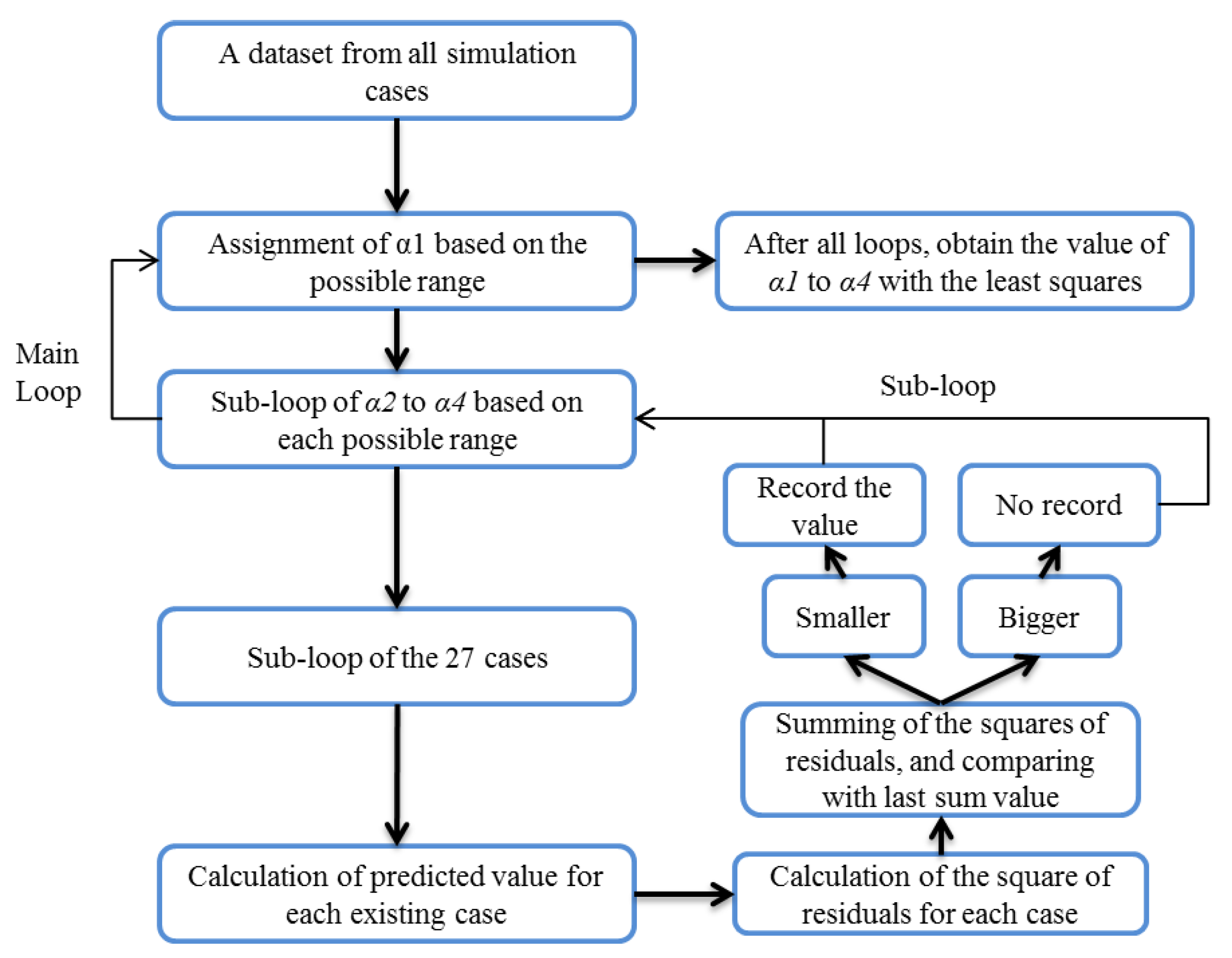
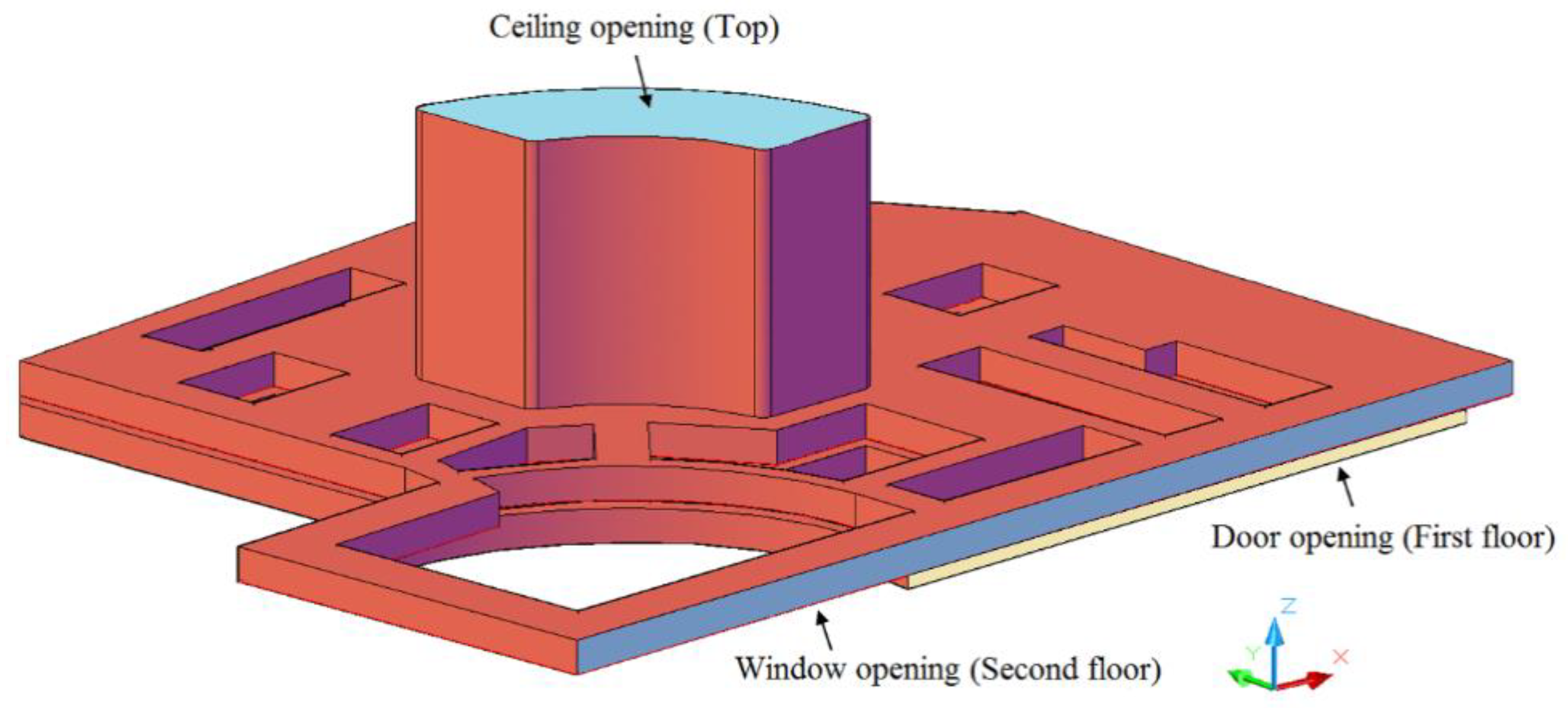
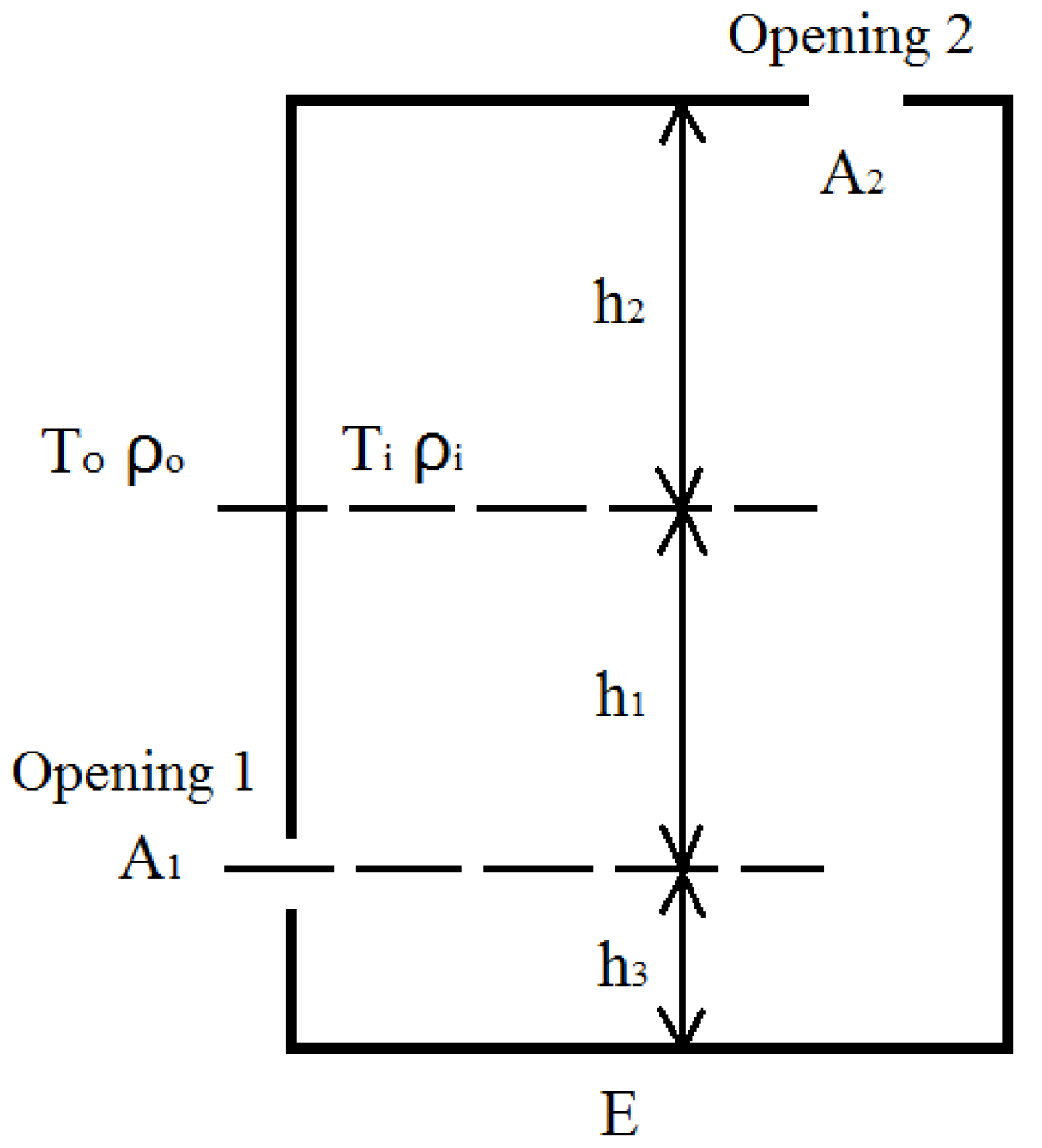
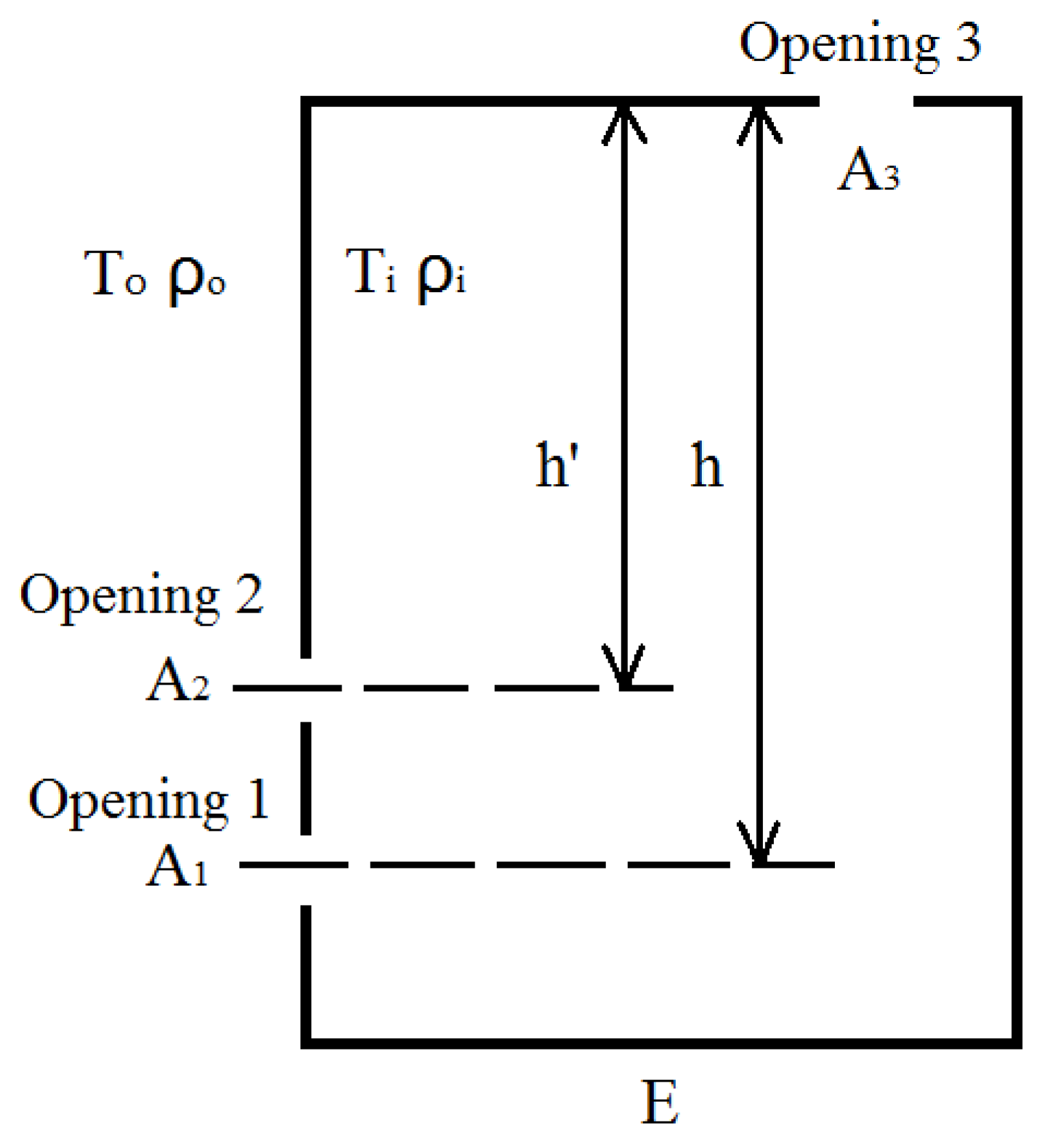
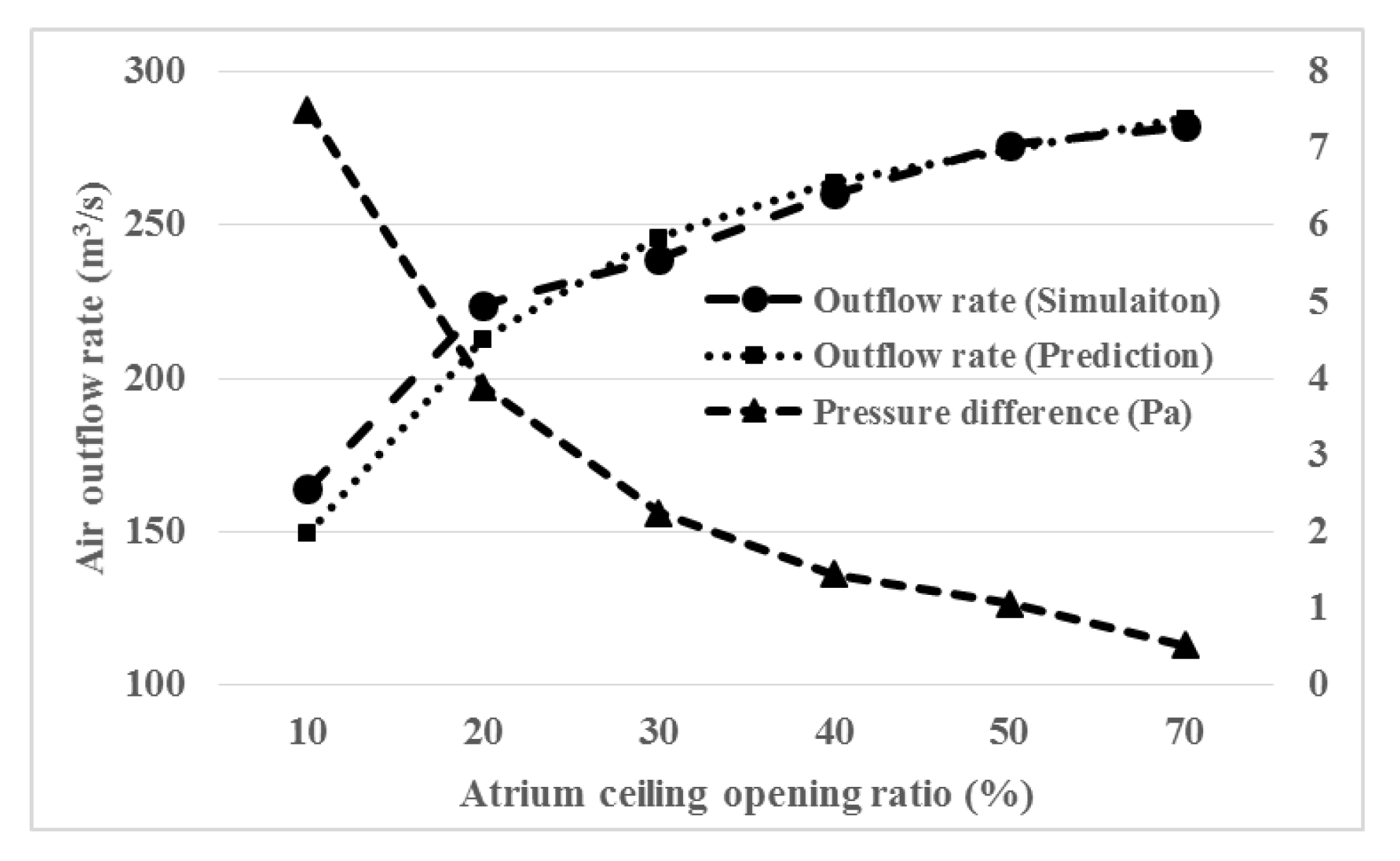
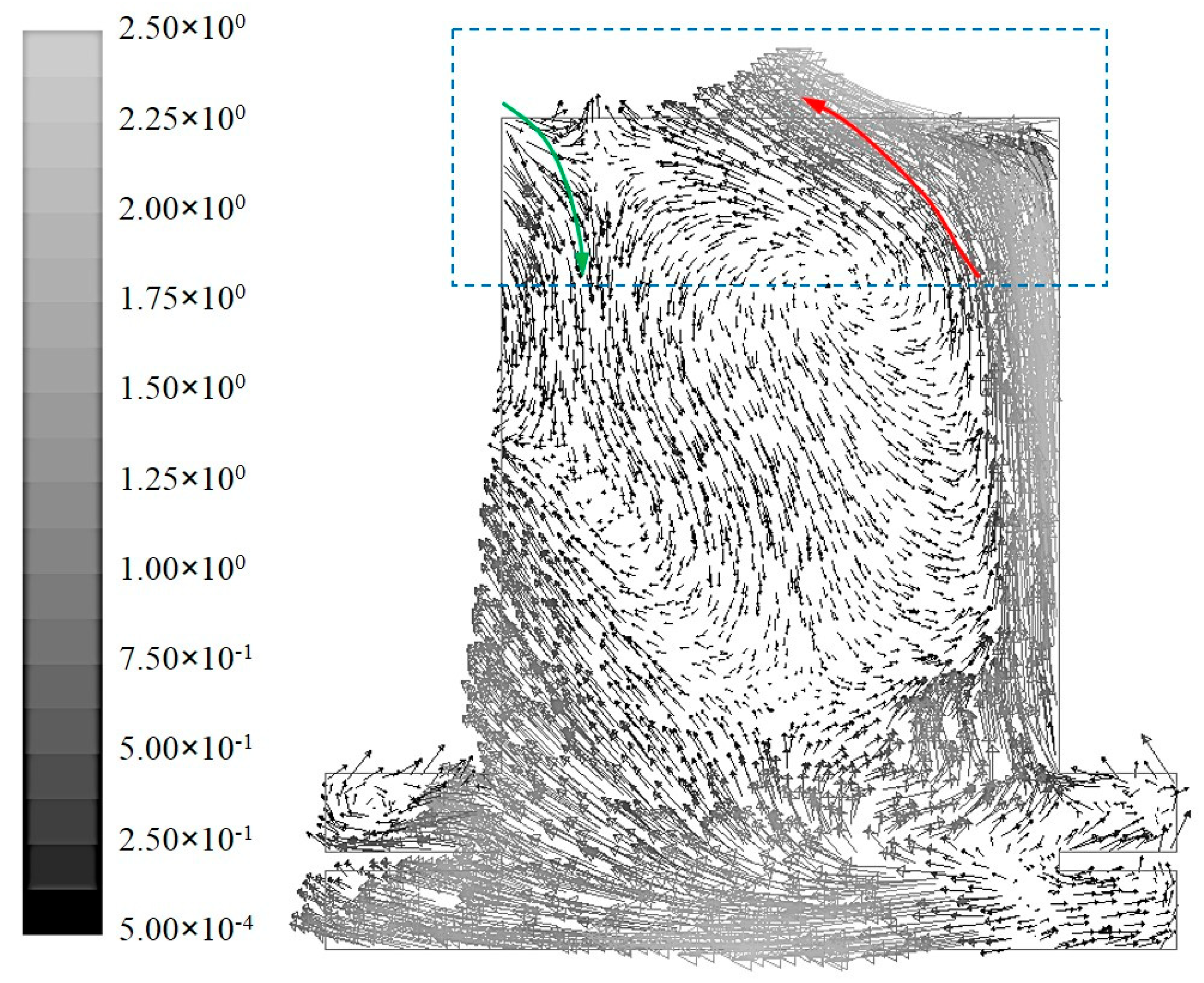

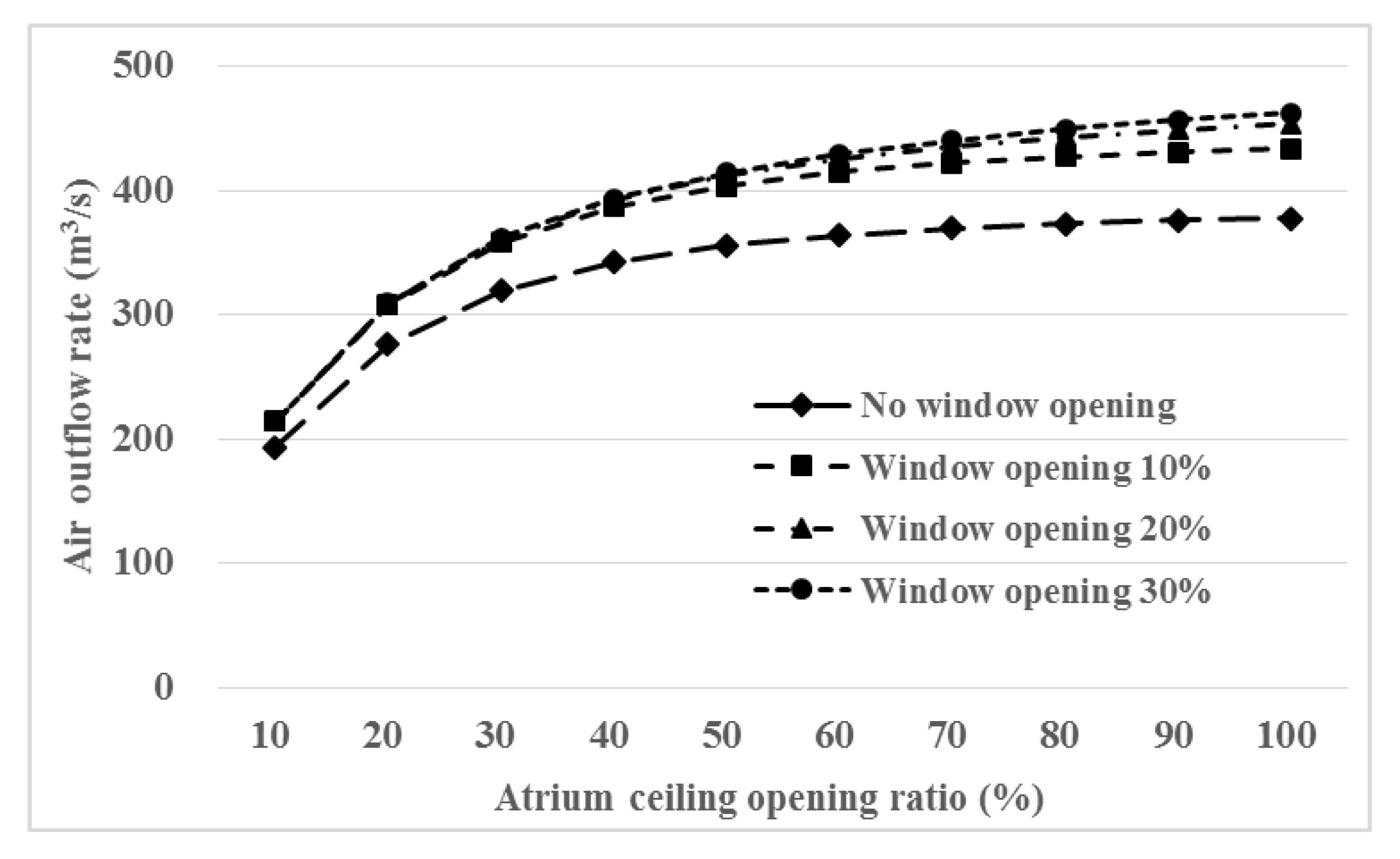
| Case | Air Flow Rate (m3/s) | A1 (m2) | A2 (m2) | A3 (m2) | E (kJ/s) | To (K) | h (m) | h′ (m) |
|---|---|---|---|---|---|---|---|---|
| 1-1 | 164 | 774 | 0 | 84 (10%) | 252 | 287 | 19.6 | none |
| 1-2 | 224 | 774 | 0 | 168 (20%) | 252 | 287 | 19.6 | none |
| 1-3(2-1) | 239 | 774 | 0 | 251 (30%) | 252 | 287 | 19.6 | none |
| 1-4 | 260 | 774 | 0 | 336 (40%) | 252 | 287 | 19.6 | none |
| 1-5 | 276 | 774 | 0 | 419 (50%) | 252 | 287 | 19.6 | none |
| 1-6 | 282 | 774 | 0 | 587(70%) | 252 | 287 | 19.6 | none |
| 2-2 | 268 | 774 | 239(10%) | 251 (30%) | 252 | 287 | 19.6 | 14.4 |
| 2-3(3-5,4-2) | 271 | 774 | 477(20%) | 251 (30%) | 252 | 287 | 19.6 | 14.4 |
| 2-4 | 275 | 774 | 716(30%) | 251 (30%) | 252 | 287 | 19.6 | 14.4 |
| 2-5 | 274 | 774 | 954(40%) | 251 (30%) | 252 | 287 | 19.6 | 14.4 |
| 2-6 | 272 | 774 | 1193(50%) | 251 (30%) | 252 | 287 | 19.6 | 14.4 |
| 3-1 | 140 | 155(20%) | 477(20%) | 251 (30%) | 252 | 287 | 19.6 | 14.4 |
| 3-2 | 162 | 232(30%) | 477(20%) | 251 (30%) | 252 | 287 | 19.6 | 14.4 |
| 3-3 | 185 | 310(40%) | 477(20%) | 251 (30%) | 252 | 287 | 19.6 | 14.4 |
| 3-4 | 217 | 387(50%) | 477(20%) | 251 (30%) | 252 | 287 | 19.6 | 14.4 |
| 4-1 | 293 | 774 | 477(20%) | 251 (30%) | 291 | 287 | 19.6 | 14.4 |
| 4-3 | 263 | 774 | 477(20%) | 251 (30%) | 218 | 287 | 19.6 | 14.4 |
| 4-4 | 251 | 774 | 477(20%) | 251 (30%) | 199 | 287 | 19.6 | 14.4 |
| 5-1 | 327 | 774 | 716(30%) | 419 (50%) | 252 | 283 | 19.6 | 14.4 |
| 5-2 | 326 | 774 | 716(30%) | 419 (50%) | 252 | 285 | 19.6 | 14.4 |
| 5-3 | 325 | 774 | 716(30%) | 419 (50%) | 252 | 287 | 19.6 | 14.4 |
| 5-4 | 322 | 774 | 716(30%) | 419 (50%) | 252 | 289 | 19.6 | 14.4 |
| 5-5 | 319 | 774 | 716(30%) | 419 (50%) | 252 | 291 | 19.6 | 14.4 |
| 5-6 | 317 | 774 | 716(30%) | 419 (50%) | 252 | 293 | 19.6 | 14.4 |
| 5-7 | 316 | 774 | 716(30%) | 419 (50%) | 252 | 295 | 19.6 | 14.4 |
| 5-8 | 312 | 774 | 716(30%) | 419 (50%) | 252 | 297 | 19.6 | 14.4 |
| 5-9 | 310 | 774 | 716(30%) | 419 (50%) | 252 | 299 | 19.6 | 14.4 |
| Activity | Body Heat Emission (W/p) | Coefficient of Community | Occupant Density (m2/p) | Equipment Load (W/m2) | Floor Area (m2) | Total Heat (kW) |
|---|---|---|---|---|---|---|
| Moderate | 235 | 0.89 | 6 | 25 | 4860 | 291 |
| Light | 181 | 252 | ||||
| Very light | 134 | 218 | ||||
| Sitting | 108 | 199 |
| Case | Simulated Value (m3/s) | Prediction Value (m3/s) | Square of Residual | Error |
|---|---|---|---|---|
| 1-1 | 164 | 149.42 | 212.52 | 8.89% |
| 1-2 | 224 | 213.02 | 120.61 | 4.90% |
| 1-3(2-1) | 239 | 245.80 | 46.25 | −2.85% |
| 1-4 | 260 | 263.95 | 15.57 | −1.52% |
| 1-5 | 276 | 274.13 | 3.49 | 0.68% |
| 1-6 | 282 | 284.59 | 6.73 | −0.92% |
| 2-2 | 268 | 275.67 | 58.81 | −2.86% |
| 2-3(3-5,4-2) | 271 | 278.01 | 49.20 | −2.59% |
| 2-4 | 275 | 278.54 | 12.54 | −1.29% |
| 2-5 | 274 | 278.73 | 22.40 | −1.73% |
| 2-6 | 272 | 278.82 | 46.56 | −2.51% |
| 3-1 | 140 | 132.98 | 49.33 | 5.02% |
| 3-2 | 162 | 162.47 | 0.22 | −0.29% |
| 3-3 | 185 | 187.64 | 6.95 | −1.43% |
| 3-4 | 217 | 208.86 | 66.19 | 3.75% |
| 4-1 | 293 | 291.67 | 1.76 | 0.45% |
| 4-3 | 263 | 264.90 | 3.62 | −0.72% |
| 4-4 | 251 | 256.97 | 35.66 | −2.38% |
| 5-1 | 327 | 320.66 | 40.22 | 1.94% |
| 5-2 | 326 | 319.91 | 37.13 | 1.87% |
| 5-3 | 325 | 319.16 | 34.09 | 1.80% |
| 5-4 | 322 | 318.42 | 12.79 | 1.11% |
| 5-5 | 319 | 317.69 | 1.71 | 0.41% |
| 5-6 | 317 | 316.97 | 0.00 | 0.01% |
| 5-7 | 316 | 316.25 | 0.06 | −0.08% |
| 5-8 | 312 | 315.54 | 12.52 | −1.13% |
| 5-9 | 310 | 314.83 | 23.36 | −1.56% |
| A1 (m2) | A2 (m2) | A3 (m2) | E (kJ/s) | To (K) | h (m) | h′ (m) | |
|---|---|---|---|---|---|---|---|
| Air flow rate | 0.0008 | 0.0000 | 0.0059 | 0.0033 | −0.0033 | 0.0030 | 0.0003 |
| Case | A1 (m2) | A2 (m2) | A3 (m2) | E (kJ/s) | To (K) | h (m) | h′ (m) | Simulated Value (m3/s) | Predicted Value (m3/s) | Error |
|---|---|---|---|---|---|---|---|---|---|---|
| 6-1 | 387 (50%) | 716 (30%) | 168 (20%) | 199 | 289 | 19.6 | 14.4 | 172.55 | 176.61 | −2.35% |
| 6-2 | 744 (100%) | 716 (30%) | 168 (20%) | 199 | 289 | 19.6 | 14.4 | 223.18 | 217.77 | 2.42% |
| 6-3 | 744 (100%) | 954 (40%) | 168 (20%) | 199 | 289 | 19.6 | 14.4 | 222.36 | 217.83 | 2.04% |
| 6-4 | 744 (100%) | 954 (40%) | 419 (50%) | 199 | 289 | 19.6 | 14.4 | 275.31 | 289.76 | −5.25% |
| 6-5 | 744 (100%) | 954 (40%) | 419 (50%) | 218 | 289 | 19.6 | 14.4 | 303.78 | 298.70 | 1.67% |
| 6-6 | 744(100%) | 954(40%) | 419 (50%) | 218 | 293 | 19.6 | 14.4 | 301.52 | 297.34 | 1.39% |
© 2019 by the authors. Licensee MDPI, Basel, Switzerland. This article is an open access article distributed under the terms and conditions of the Creative Commons Attribution (CC BY) license (http://creativecommons.org/licenses/by/4.0/).
Share and Cite
Xue, P.; Ai, Z.; Cui, D.; Wang, W. A Grey Box Modeling Method for Fast Predicting Buoyancy-Driven Natural Ventilation Rates through Multi-Opening Atriums. Sustainability 2019, 11, 3239. https://doi.org/10.3390/su11123239
Xue P, Ai Z, Cui D, Wang W. A Grey Box Modeling Method for Fast Predicting Buoyancy-Driven Natural Ventilation Rates through Multi-Opening Atriums. Sustainability. 2019; 11(12):3239. https://doi.org/10.3390/su11123239
Chicago/Turabian StyleXue, Peng, Zhengtao Ai, Dongjin Cui, and Wei Wang. 2019. "A Grey Box Modeling Method for Fast Predicting Buoyancy-Driven Natural Ventilation Rates through Multi-Opening Atriums" Sustainability 11, no. 12: 3239. https://doi.org/10.3390/su11123239
APA StyleXue, P., Ai, Z., Cui, D., & Wang, W. (2019). A Grey Box Modeling Method for Fast Predicting Buoyancy-Driven Natural Ventilation Rates through Multi-Opening Atriums. Sustainability, 11(12), 3239. https://doi.org/10.3390/su11123239








